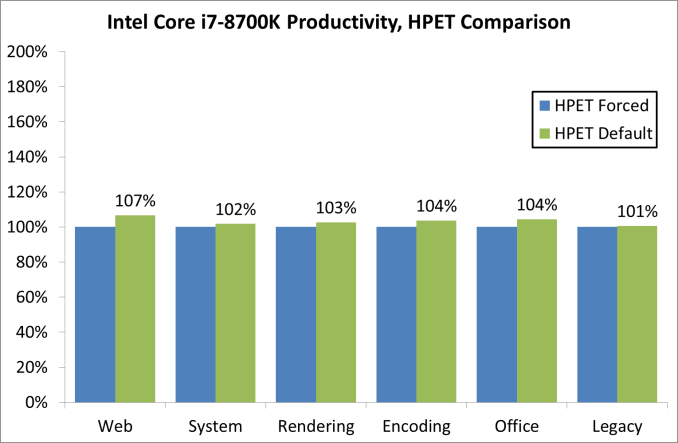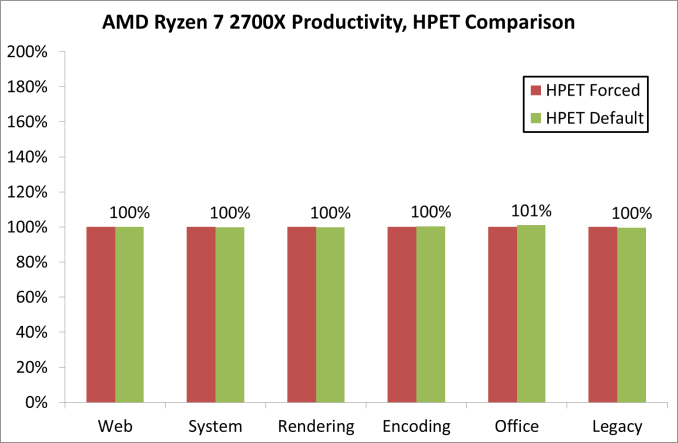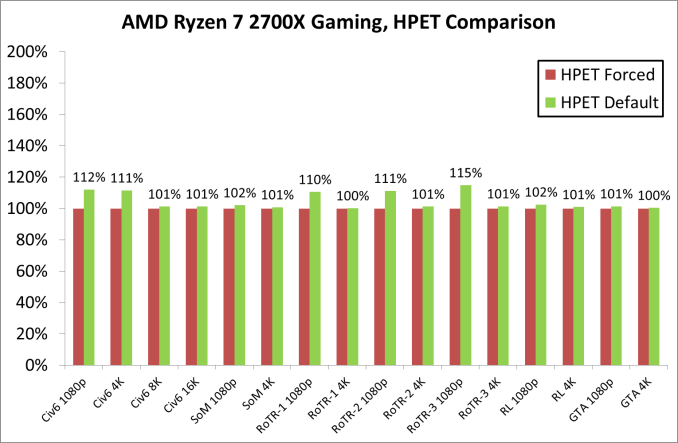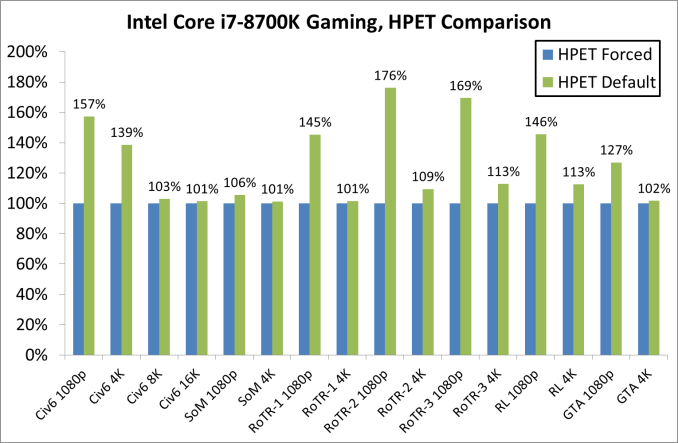A Timely Discovery: Examining Our AMD 2nd Gen Ryzen Results
by Ian Cutress & Ryan Smith on April 25, 2018 11:15 AM ESTForcing HPET On, Plus Spectre and Meltdown Patches
Based on my extreme overclocking roots back in the day, my automated benchmark scripts for the past year or so have forced HPET through the OS. Given that AMD’s guidance is now that it doesn’t matter for performance, and Intel hasn’t even mentioned the issue relating to a CPU review, having HPET enabled was the immediate way to ensure that every benchmark result was consistent, and would not be interfered with by clock drift on special motherboard manufacturer in-OS tweaks. This was a fundamental part of my overclocking roots – if I want to test a CPU, I want to make certainly sure that the motherboard is not causing any issues. It really gets up my nose when after a series of CPU testing, it turns out that the motherboard had an issue – keeping HPET on was designed to stop any timing issues should they arise.
From our results over that time, if HPET was having any effect, it was unnoticed: our results were broadly similar to others, and each of the products fell in line with where they were expected. Over the several review cycles we had, there were a couple of issues that cropped up that we couldn’t explain, such as our Skylake-X gaming numbers that were low, or the first batch of Ryzen gaming tests, where the data was thrown out for being obviously wrong however we never managed to narrow down the issue.
Enter our Ryzen 2000 series numbers in the review last week, and what had changed was the order of results. The way that forcing HPET was affecting results was seemingly adjusted when we bundle in the Spectre and Meltdown patches that also come with their own performance decrease on some systems. Pulling one set of results down further than expected started some alarm bells and needed closer examination.
HPET, by the way it is invoked, is programmed by a memory mapped IO window through the ACPI into the circuit found on the chipset. Accessing it is very much an IO command, and one of the types of commands that fall under the realm of those affected by the Spectre and Meltdown patches. This would imply that any software that required HPET access (or all timing software if HPET is forced) would have the performance reduced even further when these patches are applied, further compounding the issue.
It Affects AMD and Intel Differently: Productivity
So far we have done some quick initial re-testing on the two key processors in this debate, the Ryzen 7 2700X and Intel Core i7-8700K. These are the two most talked about processors at this time, due to the fact that they are closely matched in performance and price, with each one having benefits in certain areas over the other. For our new tests, we have enabled the Spectre/Meltdown patches on both systems – HPET is ‘on’ in the BIOS, but left as ‘default’ in the operating system.
For our productivity tests, on the Intel system, there was an overall +3.3% gain when un-forcing HPET in the OS:
The biggest gains here were in the web tests, a couple of the renderers, WinRAR (memory bound), and PCMark 10. Everything else was pretty much identical. Our compile tests gave us three very odd consecutive numbers, so we are looking at those results separately.
On the AMD system, the productivity tests difference was an overall +0.3% gain when un-forcing HPET in the OS:
This is a lower gain, with the biggest rise coming from PCMark10’s video conference test to the tune of +16%. The compile test results were identical, and a lot of tests were with 1-2%.
If Affects AMD and Intel Differently: Gaming
The bigger changes happen with the gaming results, which is the reason why we embarked on this audit to decipher our initial results. Games rely on timers to ensure data and pacing and tick rates are all sufficient for frames to be delivered in the correct manner – the balance here is between waiting on timers to make sure everything is correct, or merely processing the data and hoping it comes out in more or less the right order: having too fine a control might cause performance delays. In fact, this is what we observe.
With our GTX 1080 and AMD’s Ryzen 7 2700X, we saw minor gains across the board, however it was clear that 1080p was the main beneficiary over 4K. The 10%+ adjustments came in only Civilization 6 and Rise of the Tomb Raider.
Including the 99th percentile data, removing HPET gave an overall boost of around 4%, however the most gains were limited to specific titles at the smaller resolutions, which would be important for any user relying on fast frame rates at lower resolutions.
The Intel side of the equation is where it gets particularly messy. We rechecked these results several times, but the data was quite clear.
As with the AMD results, the biggest beneficiaries of disabling HPET were the 1080p tests. Civilization 6 and Rise of the Tomb Raider had substantial performance boosts (also in 4K testing), with Grand Theft Auto observing an additional +27%. By comparison, Shadow of Morder was ‘only’ +6%.
Given that the difference between the two sets of data is related to the timer, one could postulate that the more granular the timer, the more the effect it can have: on both of our systems, the QPC timer is set for 3.61 MHz as a baseline, but the HPET frequencies are quite different. The AMD system has a HPET timer at 14.32 MHz (~4x), while the Intel system has a HPET timer at 24.00 MHz (~6.6x). It is clear that the higher granularity of the Intel timer is causing substantially more pipeline delays – moving from a tick-to-tick delay of 277 nanoseconds to 70 nanoseconds to 41.7 nanoseconds is crossing the boundary from being slower than a CPU-to-DRAM access to almost encroaching on a CPU-to-L3 cache access, which could be one of the reasons for the results we are seeing, along with the nature of how the HPET timer works.
There is also another aspect to gaming that does not appear with standard CPU tests: depending on how the engine is programmed, some game developers like to keep track of a lot of the functions in flight in order to either adjust features on the fly, or for internal metrics. For anyone that has worked extensively on a debug mode and had to churn through the output, it is basically this. If a title had shipped with a number of those internal metrics still running in the background, this is exactly the sort of issue that having HPET enabled could stumble upon - if there is a timing mismatch (based on the way HPET works) and delays are introduced due to these mismatches, it could easily slow down the system and reduce the frame rate.














242 Comments
View All Comments
ReverendCatch - Wednesday, April 25, 2018 - link
I feel like what this ultimately means is Intel has issues with HPET, and that the results everyone else are getting are the problematic ones, not you guys. By forcing a more precise timer, intel's... I dunno... "advantage" as it were is eliminated.Seriously, AMD is 1% or less variance despite the timer used. Intel is upward of 30% or more. To me, that is a giant red flag.
nevcairiel - Wednesday, April 25, 2018 - link
Except that normal systems are not going to force HPET, so the more real-world realistic tests/results should really be used.ReverendCatch - Wednesday, April 25, 2018 - link
The question I suppose I have is, are the results even real or legit at that point. Why does the intel suffer tremendously when using an accurate timer, and pulls ahead when not?How does that not sound fishy to you?
tmediaphotography - Wednesday, April 25, 2018 - link
From my reading of the article, it seems that Intel takes a larger hit because they use a more accurate HPET timer (24Mhz on the 8700K), and thus it is more taxing on the system. The calls are very much under the umbrella of things more negatively affected by Spectre, and as the i7 8700K system had an HPET rate at closing on 2x as much as the R7 2700K, it stands to reason the i7 is going to benefit much more from it being turned off.tl;dr, the more accurate timer is much more needy on the system, and the system under spectre/meltdown takes an even larger hit at the IO calls to it.
Billy Tallis - Wednesday, April 25, 2018 - link
The HPET can run at a higher frequency without generating more CPU overhead, because it's really just a counter. Making that counter's value grow more quickly doesn't mean the CPU gets more interrupts per second.patrickjp93 - Wednesday, April 25, 2018 - link
Because it makes perfect sense. Intel's losing more clock cycles since it is at vastly higher clock speeds, and it has Meltdown to contend with on top of Spectre. HPET from my cursory reading is 4 system calls compared to just 2 for TSC+lapic. The performance hit of that should then surprise no one.With AVX-512, Intel has a lot of very high throughput instructions that AMD doesn't. If your software uses them, Intel pulls ahead vs. the best equivalent you could write for Epyc. That's not fishy. You're just taking the more optimal path to solving your problem. When Cascade Lake X and Cannon/Ice Lake arrive, this will all be fixed at the hardware level and the overhead will disappear.
Cooe - Wednesday, April 25, 2018 - link
Except that isn't actually true in practice for a wide variety of actual AVX-512 enabled workloads. Running those insanely wide registers drastically increases power draw & thermal ouput and as a result clock-speeds take a nose-dive. In certain SIMD workloads capable of AVX acceleration, this clock-dropoff is so large that EPYC outperforms Skylake-X's AVX-512 support using much much narrower AVX2 instructions/registers simply because it can maintain vastly higher clock-speeds during the load.Heck AnandTech even verified this with their own testing way back when. https://www.anandtech.com/show/12084/epyc-benchmar...
patrickjp93 - Wednesday, April 25, 2018 - link
If you're using the widest registers, yes, but there were also a lot of 128 and 256-bit extensions added that were missing from the AVX/2 stack. And Intel will bring the power draw down and the clocks up over time.Dolda2000 - Wednesday, April 25, 2018 - link
The HPET, despite its name, is not more accurate. The TSC timer is accurate to CPU clock-cycle precision, which is usually more than two orders of magnitude better than the HPET.Billy Tallis - Wednesday, April 25, 2018 - link
The difference between accuracy and precision is probably important here. TSC is definitely far more precise, but overclocking can make it much less accurate.